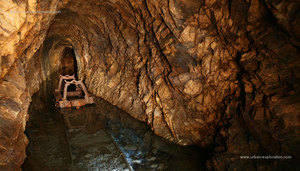imported document on the site 2008-09-13 and amended for the last time 2010-09-23
The origin of the silver-lead mines Trémusson is Roman. It was already long pieces of Roman origin in the galleries. An excavation site has confirmed the original site, by the discovery of tiles to hook on both sides of the creek.
In the late 17th century, the English are precursors in the mining of nonferrous metals. They buy logging concessions in Britain. However, the site is still not exploited Trémuson. The concession is then awarded on 1 April 1732 to a Breton of Morlaix Guillotou of Kerver. Speculation around the precious metal is growing, which does not prevent the owner from going bankrupt due to a bad investment.
In 1740 the Mining Company of Lower Britain bought the concession. It will take 40 years to industrialize the mines. In 1782, more than 500 people work at the mine site. The size of the concession is over 90,000 hectares. It will never be fully exploited. At the end of the 19th century, the exploitation fall. The owners regularly change without success.
It was not until 1922 that the operation resumes. A laundry room is built on a hillside in 1924. She can wash the ore and the sort because the deposit is less rich than in ancient times. A year later, a foundry was built. The operation is successful for ten years, then the company suffers Dufourg the general crisis. In 1931, the mine was permanently closed. It will never be exploited.
Today, the mines are protected refuges for bats but the many miles of tunnels continue to drain the lead in the village by water infiltration. The villagers can not eat vegetables from their gardens or drink water polluted groundwater. There are remains of the laundry and the foundry behind the village.
source: patrimoine.region-bretagne.fr(FR)
In the late 17th century, the English are precursors in the mining of nonferrous metals. They buy logging concessions in Britain. However, the site is still not exploited Trémuson. The concession is then awarded on 1 April 1732 to a Breton of Morlaix Guillotou of Kerver. Speculation around the precious metal is growing, which does not prevent the owner from going bankrupt due to a bad investment.
In 1740 the Mining Company of Lower Britain bought the concession. It will take 40 years to industrialize the mines. In 1782, more than 500 people work at the mine site. The size of the concession is over 90,000 hectares. It will never be fully exploited. At the end of the 19th century, the exploitation fall. The owners regularly change without success.
It was not until 1922 that the operation resumes. A laundry room is built on a hillside in 1924. She can wash the ore and the sort because the deposit is less rich than in ancient times. A year later, a foundry was built. The operation is successful for ten years, then the company suffers Dufourg the general crisis. In 1931, the mine was permanently closed. It will never be exploited.
Today, the mines are protected refuges for bats but the many miles of tunnels continue to drain the lead in the village by water infiltration. The villagers can not eat vegetables from their gardens or drink water polluted groundwater. There are remains of the laundry and the foundry behind the village.
source: patrimoine.region-bretagne.fr(FR)
comment from : roukinox - posted 2015-02-06 20:48:37
Joli cliché, j'espère en faire autant demain.

